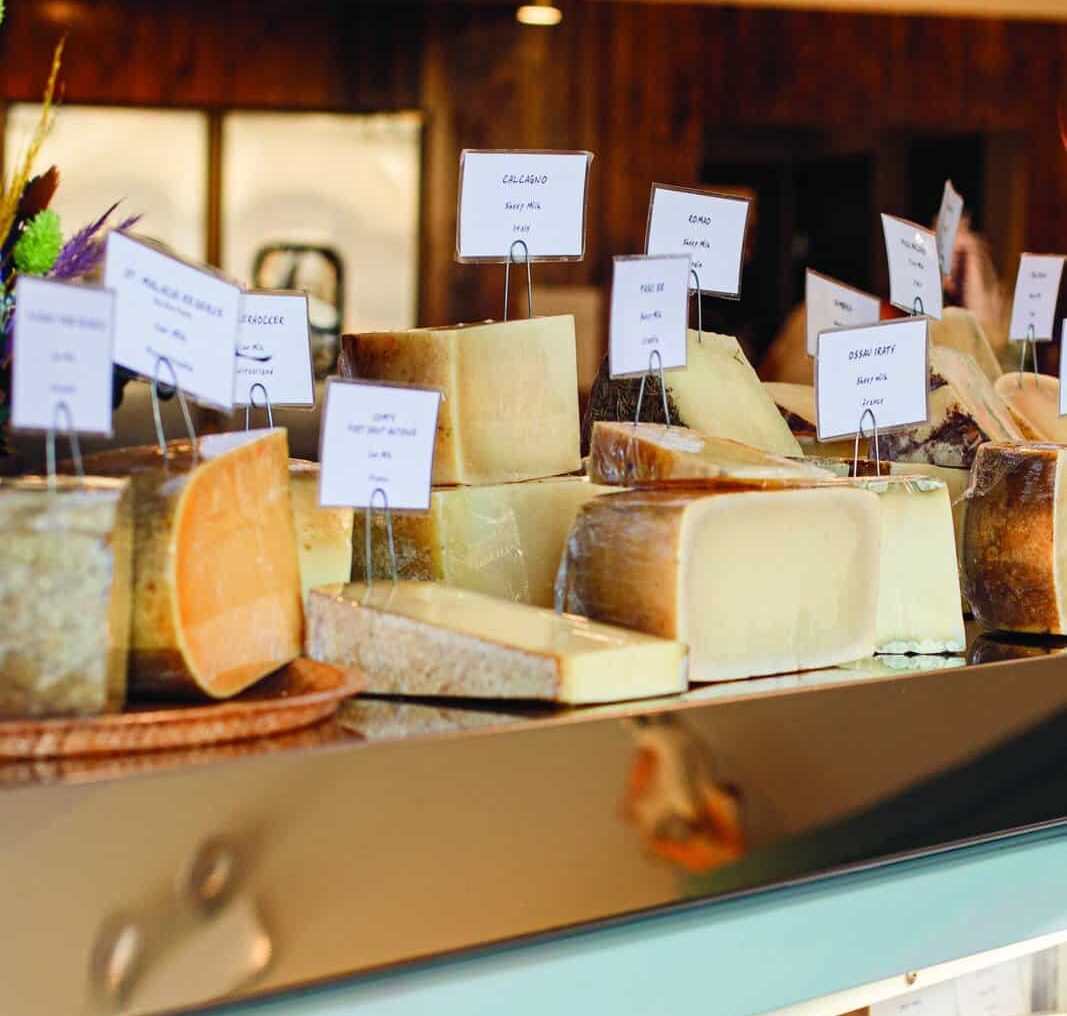
Want to impress your friends and/or local monger? Expand your curd-lexicon! Our cheese dictionary is packed with terms to help you understand cheeses and talk to cheesemakers and cheesemongers with confidence:
Affinage: The craft of maturing and aging cheeses, from the French word affiné, which translates to finished or refined.
Affineur: The person who cares for cheeses during the aging process.
Ammoniated: A term that describes a cheese that smells or tastes of ammonia due to being overripe or mishandled, usually in soft, bloomy-rind, or washed-rind cheeses, such as brie, camembert, and chèvre.
Annatto: An odorless, tasteless, natural vegetable extract derived from achiote seeds for red, orange, or yellow coloring in such cheeses as cheddar, Cheshire, and Red Leicester.
Beta-carotene: Beta-carotene is a group of red, orange, and yellow pigments called carotenoids. It naturally occurs in grass and imparts yellow coloration to the milk fat in cow’s milk. It is also a building block for the production of fat-soluble vitamin A.
Brevibacterium linens (B. linens): Harmless bacteria cultivated on the surface of washed-rind cheeses, which create an orange or pinkish hue and a bracing odor. B. linens require moisture, oxygen, and a low-acid environment to flourish.
Brined cheese: A term used to classify cheeses that are stored in brine, such as feta.
Bruised: A term that describes a cheese as off-color, dented, or with other physical irregularities.
Casein: The primary protein in milk.
Cendré: A term indicating that a cheese is sprinkled with dark vegetable ash, commonly on young goat’s milk cheeses.
Cheese trier: Resembling an apple corer, a cheese trier is used to extract a small sample from the center of a cheese wheel.
Close: A term that describes cheese with a smooth, tight texture, such as cheddar.
Cream line: The layer of cheese just beneath the rind. This tends to be creamier and runnier than the interior paste, and can be thick or thin, depending on the size, age, and style of the cheese.
Curd: The solids formed after milk has coagulated as during the cheesemaking process.
Eyes: Holes within cheese, such as swiss, formed by trapped gas due to fermentation during the curing process.
Farmstead cheese: Cheese produced with only milk from the farm where the cheese is made.
Ferme/Fermier: A French term for farm-produced cheeses.
Filled: A term for cheese whose butterfat has been removed and replaced with vegetable oil. Filled cheese is also referred to as imitation cheese.
Fromager: French for cheesemaker.
Galactomyces candidum: Formerly (and still often) known as Geotrichum candidum, Galactomyces is a yeast-like mold used secondarily in the maturation of bloomy-rind and washed-rind cheeses. In the former, it grows prior to developing a bloomy rind and prevents P. candidum from overtaking the cheese and leading to bitterness; in the latter, it is used to deacidify the surface of the cheese, creating a hospitable environment for B. linens.
Gassy: A term for cheese that becomes bloated in packaging, due to an increase in holding temperature or altitude, or indicating microbial production of carbon dioxide.
Green: A cheese that is not yet fully ripened.
Guillotine: A contraption used to cut clean wedges, especially useful for blue or other soft cheeses.
Homogenization: The process by which fat globules are made uniform in size and evenly distributed throughout the milk.
Hot performance: How a cheese responds to heat, which depends on its form and hardness, and the temperature and length of cooking time.
Hygrometer: An instrument used to measure temperature of and humidity in the air—essential in an aging cave.
Interior mold: Mold (most often blue) that grows in the interior of a cheese. This mold can be introduced by piercing the cheese with needles to introduce oxygen, or it can form in an open rind and natural space between the curds.
Lactase: An enzyme that splits lactose molecules into the simple sugars glucose and galactose. People who are lactose intolerant lack this enzyme and can often take pills to supplement it.
Lactic acid: A product of the breakdown of lactose with low pH.
Lactic bacteria: Bacteria that break down lactose molecules, leaving behind lactic acid.
Lactose: A sugar molecule present in milk.
Lipase: An enzyme that breaks down fat molecules.
Marbled: A term that describes a cheese in which two colors of curd are blended, or where a colored flavoring agent (such as sage or coffee) has been introduced, showing a colorful contrast between the curds.
Milling: Breaking up the curd after it has rested and ripened before pressing.
Moisture content: The amount of water in a cheese.
Oil-off: The separation of oil from solid when cheese melts.
Open: A term that describes cheese with small holes, such as Colby.
Paste: The interior of a cheese beneath the outer rind, which can range in texture from soft and creamy to firm and smooth to hard, dry, and crunchy.
Pasteurization: The process of heating something to a high temperature for a set length of time to kill off pathogens.
Penicillium candidum (P. candidum): A mold often added to soft-ripened cheeses to promote the growth of a white, bloomy rind.
Penicillium roqueforti (P. roqueforti): The primary mold used in the making of blue cheese. Originally found in cheese caves in Roquefort, France.
pH: A measure of acidity.
Pricking: The process of piercing cheese with long needles to introduce the air necessary for certain types of fermentation, usually blue mold growth.
Protease: An enzyme that breaks down dairy proteins.
Raw milk: Milk that has not been pasteurized.
Recombinant Bovine Growth Hormone (rBGH): A synthetic version of BGH given to dairy cows to increase milk production.
Rennet: An enzyme used to coagulate milk. Technically, rennet is derived from the membrane lining the stomach of a calf, though the term is now used to describe any enzyme—animal, vegetable, or microbial— used to curdle milk in cheesemaking.
Retronasal: The perception of aroma (and thereby flavor) by inhaling scent molecules through the mouth.
Ripening: A word used to describe both the period of and changes during the aging of a cheese.
Rind: The exterior of a cheese. This can be inedible (plastic, wax, or cloth), natural, mold-covered, or flavored.
Soapy: A description of taste caused by long-chain fatty acids, which can occur from excessive breakdown of milk fat in cheese.
Starter: Also called a started culture. A bacterial culture that converts lactose into lactic acid, lowering the pH of the milk at the beginning of the cheesemaking process (see lactic bacteria).
Surface-ripened: Cheese that ages from the outside in, due to microorganisms (mold) introduced to its exterior.
Terroir: A French word that describes characteristics given to a food by the area in which it was grown, including soil, climate, and altitude.
Thermalization: The process of heating milk to less than 160°F for fewer than 15 seconds prior to cheese production—a lower temperature for a shorter period than that of pasteurization.
Thermophilic: Bacteria that thrive between the temperatures of 86°F and 122°F.
Tomme: A French term indicating a small round of cheese; smaller tommes are known as tommettes. Also a generic name given to a class of cheese produced mainly in the French Alps from leftover skim milk after the cream has been removed to produce butter and richer cheeses. As a result, tommes are generally low in fat.
Triple cream or triple crème: A fresh, soft French cheese containing at least 72 percent fat.
Transhumance: Seasonal guided migration of animals to higher Alpine pastures, especially in the French and Swiss Alps, where they graze on open fields of grass. Cheese (Gruyère, Beaufort, Appenzeller, Comté) is produced after each milking.
Turophobia: Fear of cheese.
Tyrosemiophilia: The hobby of collecting cheese labels, as mentioned by Thomas Pynchon in his debut novel, V.
Ultra-pasteurization: The process of heating milk to a higher temperature for a shorter period than that of regular pasteurization, which results in a longer shelf life but still requires refrigeration.
Unsaturated fat: A type of fatty acid that is not saturated with carbon atoms because some of those atoms have bonded with each other. This type of fat is more prevalent in plant-derived foods.
Veining: The mold in blue cheeses.
Vertical tasting: A sample of the same cheese at various ages, from as young as possible to well-aged, if not overripe.
Washed-curd: A cheese that has had some of its whey drained and replaced with hot water. This reduces the amount of lactose available for conversion into lactic acid and results in a sweeter cheese after aging. Gouda is an example of a washed-curd cheese.
Waxed: A protective coating of cheesecloth and wax for preservation. Many wax colors denote some attribute of the cheese. For example, with cheddar: clear = mild, red = medium, and black = aged or sharp.
Weeping: A term that refers to a release of moisture from the eyes of swiss-type cheeses, caused by proteins being broken down during ripening. Weeping often indicates that a cheese has achieved peak ripeness and will exhibit full flavor, or that it has been stored at too warm of a temperature.
Whey: The leftover liquid after milk has coagulated.
Whey cheese: A cheese made from coagulated whey proteins, such as traditional ricotta.
Young: Semi-firm, firm, or hard cheeses that have been cured for two weeks to 30 days; such cheeses usually have milder flavors.




